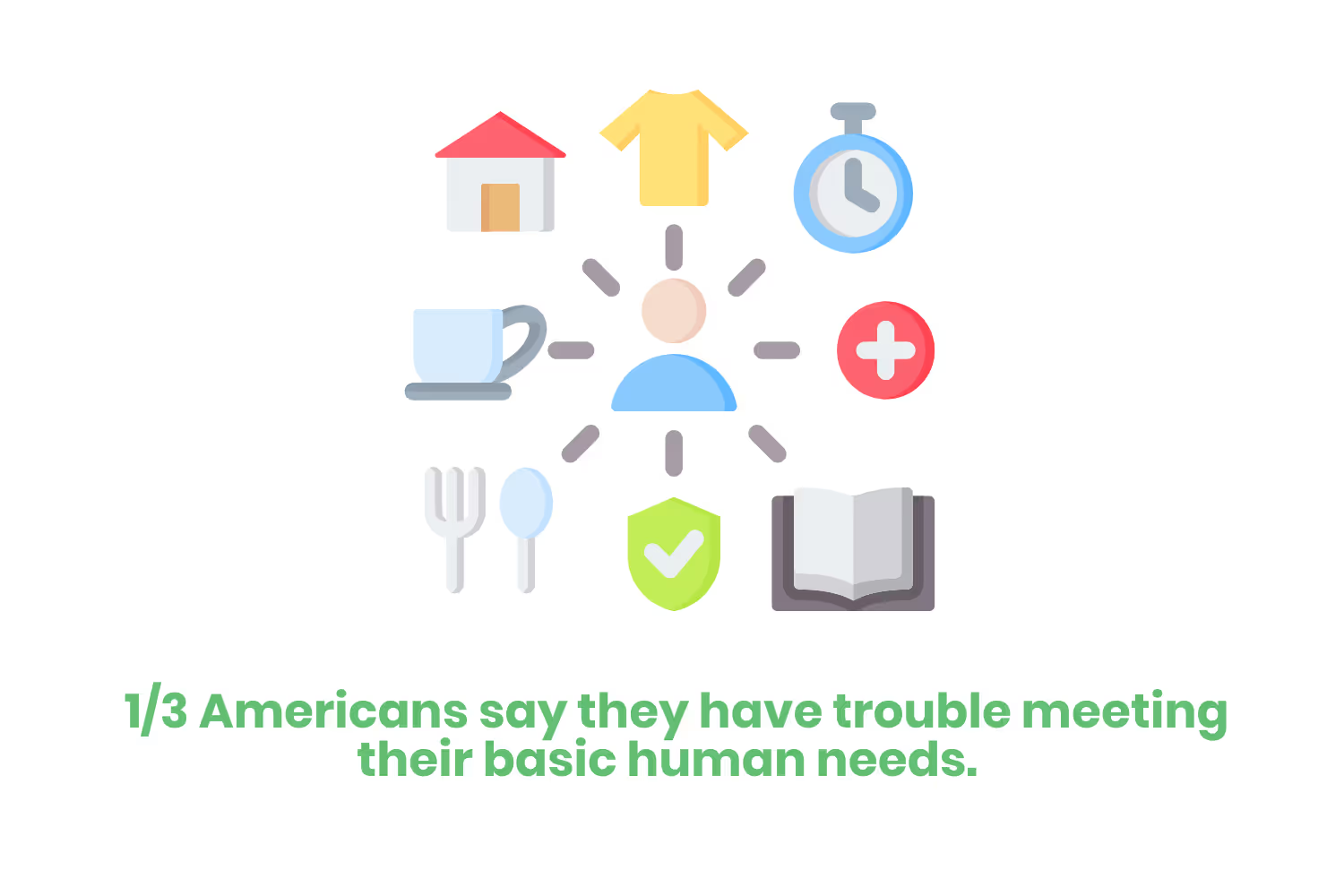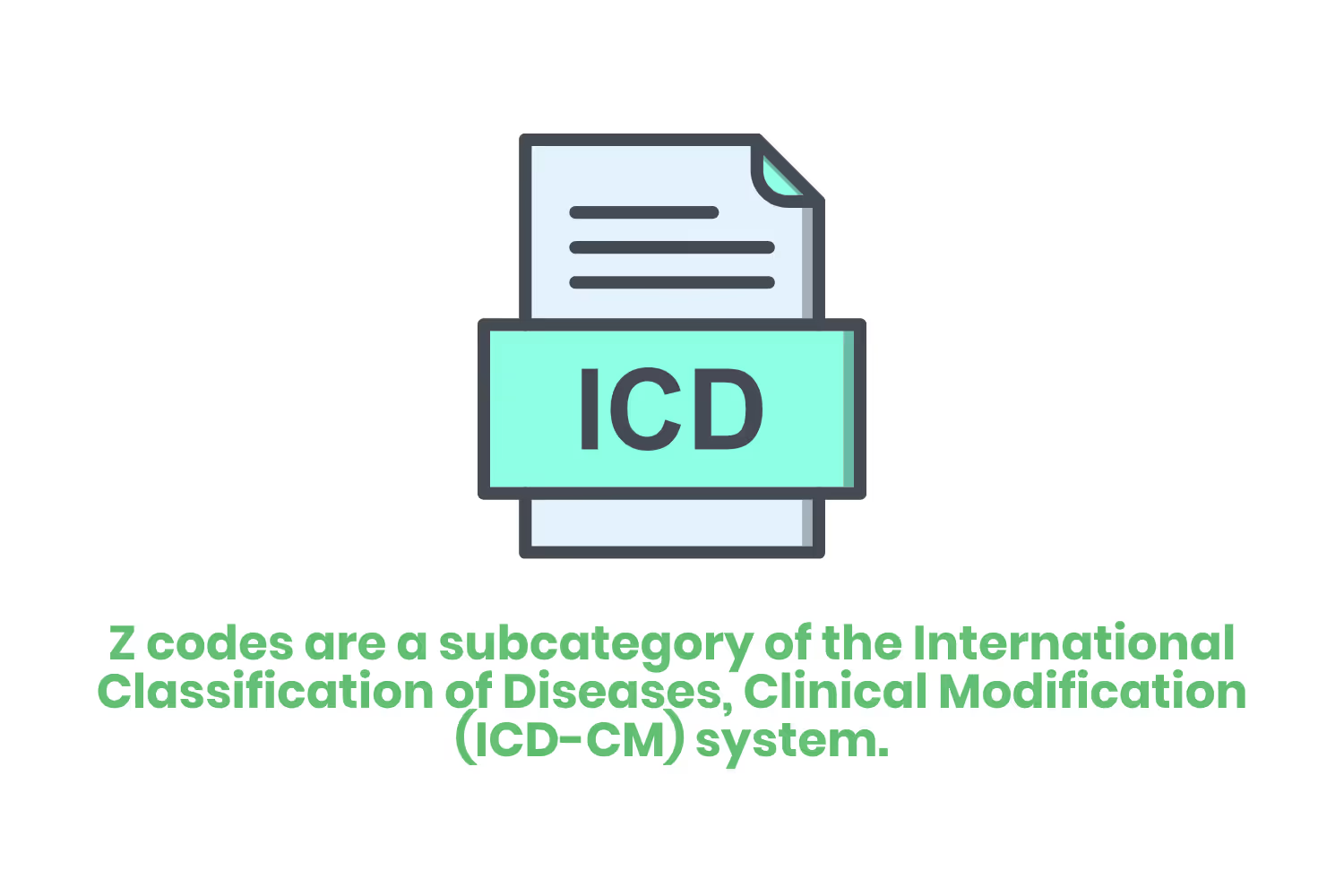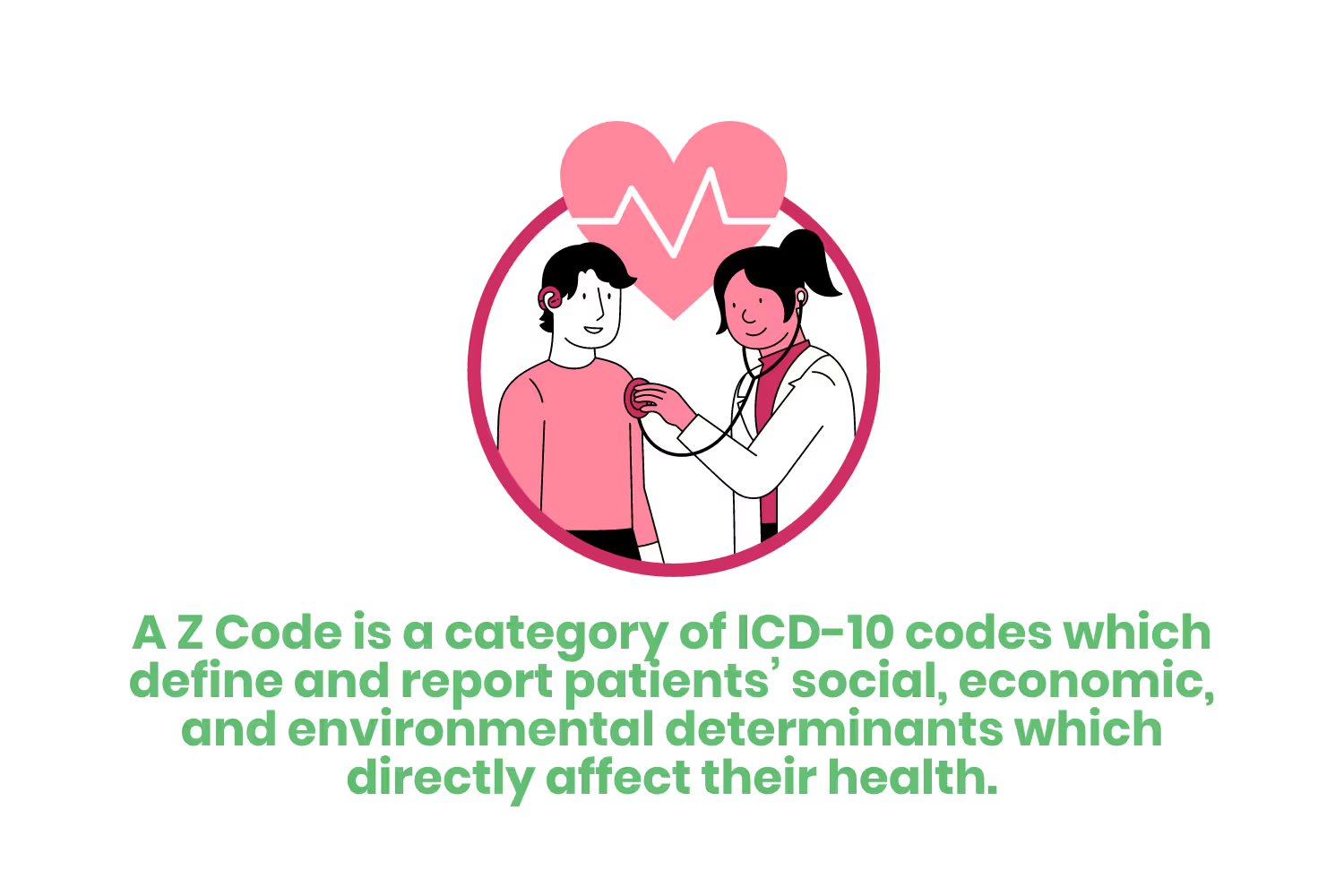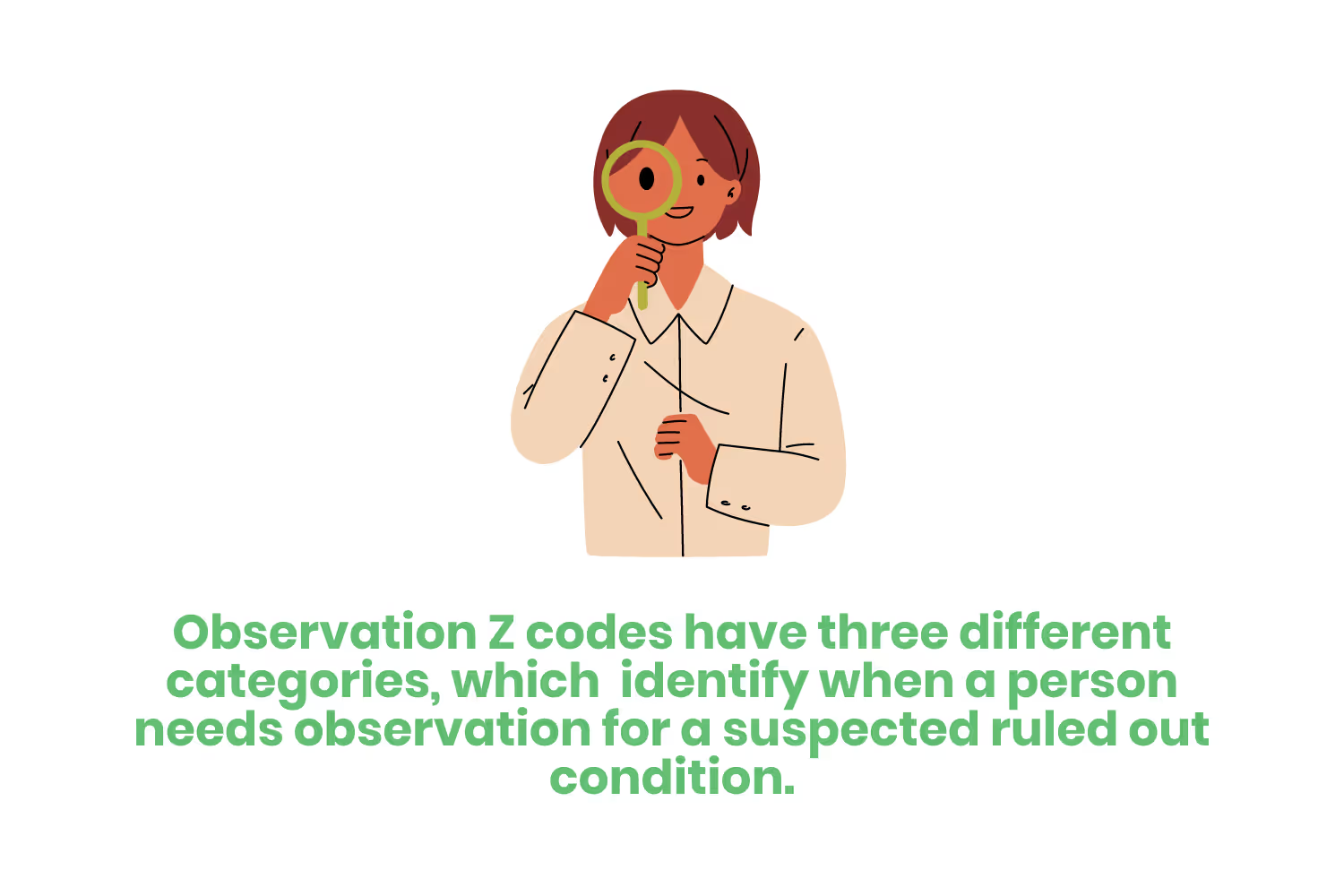Z Codes in ICD 10: Everything You Need to Know
In this blog we dive further into Z codes, what exactly they are, what role they play in medical billing and the different categories which help cover all sorts of unique circumstances.

According to a report by Kaiser Permanente, one-third of Americans say they have trouble meeting their basic human needs. Basic human needs include things such as stable housing, adequate food, and reliable transportation. Four in ten said they would turn to their healthcare provider when looking for helpful resources to meet those needs. This is why providers have more responsibility in the exam room than just simply focusing on symptoms and primary diagnoses.

ICD-10-CM Codes Overview
Z codes are an important part of diagnosing. They are a subcategory of the International Classification of Diseases, Clinical Modification (ICD-CM) system, which is a pillar in the field of medical documentation and coding. Z codes capture a wide scope of non-diagnostic factors that influence a patient’s health status. This includes social and environmental factors. So now you see how it all ties together!
We will dive further into Z codes, what exactly they are, what role they play in medical billing and the different categories which help cover all sorts of unique circumstances.
What are Z Codes in ICD-10-CM?
So what is a Z Code? It is a category of ICD-10 codes that define and report patients’ social, economic, and environmental determinants which directly affect their health. These codes are not considered procedure codes but instead offer more comprehensive insight on the patient's status and contact with health services. This means that a corresponding procedure code must accompany your Z code to describe any procedures performed. You can find these codes in many different healthcare settings such as doctors’ offices, hospitals, and skilled nursing facilities.
Categories of Z Codes: Z00-Z99
Z Codes (Z00-Z99) act as further explanation for a patient’s visit to a healthcare facility. Depending on the encounter, Z Codes can be either a principal/first-listed or secondary code. However, note that certain Z Codes are not interchangeable between these diagnosis codes. These specific Z codes can only be a principal/first-listed or a secondary code. Again, it all depends on specific situations!

Next up we are talking about something less convoluted. This might seem obvious, but Z Codes always start with the letter “Z”, with numbers and/or letters following. Some common Z Codes include (but are not limited to):
- Z00.4 General psychiatric examination, not elsewhere classified.
- Z03.2 Observation for suspected mental and behavioral disorders.
- Z09.3 Follow-up examination after psychotherapy.
- Z13.4 Special screening examination for certain developmental disorders in childhood.
- Z56.0 Unemployment.
- Z59.0 Homelessness.
- Z59.1 Inadequate Housing.
- Z50.2 Problems related to living alone.
- Z59.3 Problems related to living in a residential institution.
- Z62.0 Inadequate parental supervision and control.
- Z62.21 Child in welfare custody.
- Z63.0 Problems in relationship with spouse or partner.
- Z63.4 Disappearance and death of family member.
- Z71.9 Counseling, unspecified.
How Do Z Codes Influence Health Status?
Now it’s time to tell you why Z codes are so important in the healthcare industry. I’ll go over just a few of the many reasons you should understand them.
First, they help you elevate your patient care potential while improving medical accuracy. Clinicians use these codes to account for factors influencing health status. As well as record any potential health hazards related to a patient's condition. Z codes can help provide a larger scope of a patient’s health and wellness status. This allows providers to personally tailor care plans to patients based on a multitude of factors.
Z codes also offer support for healthcare planning and resource allocation. What does this mean? This means that policy health agencies can use these codes to identify public health trends and therefore, distribute resources needed. Insurance and reimbursement also depend on accurate Z code documentation.

What is the Role of Z Codes in Health Services?
We went over “what”, “why”, and now let me tell you about “when”. Using Z codes can feel tricky in nature, but I assure you it’s rather straightforward. The intention of these codes is to ensure your patient receives the necessary attention depending on their particular circumstances. Some situations include:
- When a person receives treatment for a specific purpose or current condition. This applies whether a person is sick or not. A Z code can apply if the patient only wishes to discuss a problem that is not an illness or injury in itself.
- When something that is not an injury or disease affects a patient’s health status.
Routine health checkups also tend to use Z codes, even when no specific health issues are apparent. Let’s go over a few more situations and/or categories in which you can expect to run into Z codes.

Contact/Exposure/Occupational Exposure
This category indicates the suspected contact or exposure to both communicable diseases and other hazards to someone’s health. The Z code is for patients suspected of having contact with a disease through close proximity with an infected individual or in an area where a disease is epidemic.
These codes can be a first-listed code or (more commonly) a secondary code. First-listed contact/exposure codes explain an encounter for testing, while secondary codes identify a potential risk. The contact/exposure categories are:
- Z20 Contact with, and suspected exposure to, communicable diseases.
- Z77 Other contact with and (suspected) exposures hazardous to health.
Inoculations and Vaccines
Codes regarding visits having to do with inoculations and vaccines suggest that a patient is being seen for preventative vaccinations. Procedure codes must explain what the administration of the injection is as well as the type of immunization used.
If the inoculation is part of a routine preventative healthcare service, the Z code is likely to be a secondary code. The inoculations and vaccine category: Z23 Encounters for inoculations and vaccinations.
Status and Disease
Status Z codes suggest that a patient is a current carrier of a disease or has the residual of a past disease. This includes (but is not limited to) things such as prosthetic devices, which are resulting from past treatment.
This Z code is important, as it can help a provider deliver the best course of treatment and outcome. However, note that a status code is different from a history code, as history codes indicate a patient who no longer has the condition. Examples of status categories include (but are not limited to):
- Z14 Genetic carrier.
- Z18 Retained foreign body fragments.
- Z19 Hormone sensitivity malignancy status.
- Z21 Asymptomatic HIV infection status.
- Z22 Carrier of infectious disease.
- Z68 Body mass index (BMI).
History (of) and Genetic Susceptibility
As I touched on in the previous section, history codes are different from status codes in a few ways. The two types of history codes are “personal” and “family”. Personal history codes help explain an individual’s past condition that they no longer have. This patient is thus not receiving treatment, but note that the condition does have the potential for recurrence. Personal history codes are often conjoined with follow-up codes.
A family history code is necessary when the individual has a family member(s) who have the condition currently or in the past. This increases the likelihood of the patient contracting the disease and thus, requires monitoring. These can partner with screening codes to explain the need for a test or procedure. History codes are appropriate to include on any medical record. Examples of history categories include (but are not limited to):
- Z81 Family history of mental and behavioral disorders.
- Z82 Family history of certain disabilities and chronic diseases.
- Z86 Personal history of certain other diseases.
- Z87 Personal history of other diseases and conditions.
Screening
Screening codes state that a patient is going through testing for a suspected disease or disease precursors. These patients are seemingly well individuals. These tests are important for early detection so that treatment is available for the patient for the best possible outcome. If the patient presents symptoms, this is then not a screening but instead a diagnostic exam.
Screening codes are a first-listed code if the visit is only for a screening exam. When the visit is for any other reason, with a screening performed additionally, it is then an additional code.
Screening Z codes are not necessary for screenings that are a part of routine visits. An example might include a pap smear done during a routine pelvic exam. The screening categories are:
- Z11 Encounter for screening for infectious and parasitic diseases.
- Z12 Encounter for screening for malignant neoplasms.
- Z13 Encounter for screening for other diseases and disorders. Except: Z13.9, Encounter for screening, unspecified.
- Z36 Encounter for antenatal screening for mother.
Observation
Observation Z codes have three different categories, all are for use in very limited situations. These codes identify when a person needs observation for a suspected ruled-out condition. This means that the patient is not currently presenting signs, symptoms, injury, or illness related to the suspected condition.
Observation codes are usually principal/first-listed diagnoses but can be a secondary diagnosis code when observing a patient for a condition unrelated to the principal/first-listed diagnosis. These codes aren't necessary if the provider confirms the condition. The three observation categories are:
- Z03 Encounter for medical observation for suspected diseases and conditions ruled-out.
- Z04 Encounter for examination and observation for other reasons. Except: Z04.9 Encounter for examination and observation for unspecified reason.
- Z05 Encounter for observation and evaluation of newborn for suspected diseases and conditions ruled-out.

Aftercare
Aftercare codes are helpful in circumstances in which a patient already received initial treatment for a disease and now requires continued care during recovery. These codes are not appropriate to use if the treatment is for a current, acute disease. You should not use aftercare Z codes to code the aftercare of an injury. For injury aftercare, use the acute injury code. Examples of aftercare categories include (but are not limited to):
- Z43 Encounter for attention to artificial openings
- Z44 Encounter for fitting and adjustment of external prosthetic device.
- Z49 Encounter for care involving renal dialysis.
- Z51 Encounter for other aftercare and medical care.
Follow-up Healthcare
Follow-up Z codes explain extended surveillance of a disease, condition, or injury after treatment. When using this code, medical records suggest that the condition no longer exists and that the treatment was successful. This is what differentiates a follow-up code from an aftercare code, or injury code.
History codes and follow-up codes can often complement each other to provide a detailed retelling of the initial condition and its treatment. In this case, the follow-up code would come first, then followed by the history code. The follow-up categories are:
- Z08 Encounter for follow-up examination after completed treatment for malignant neoplasm.
- Z09 Encounter for follow-up examination after completed treatment for conditions other than malignant neoplasm.
- Z39 Encounter for maternal postpartum care and examination.
Donor
Donor Z codes are pretty self-explanatory, but I’ll go over them anyway. Providers use these codes for living individuals who choose to donate blood or any other body tissue. These codes are for self-donations as well as those who donate to others. These codes do not identify the donations taken from cadavers. The obstetrical and reproductive services category is Z52, Donors of organs and tissues.
Counseling and Mental Health
When support or coping is necessary due to the aftermath of an illness or injury, you will want to use counseling codes. These apply to either the patient, a family member, or both. Also, offering counseling for an individual navigating a social or familial situation will require the use of these Z codes. Examples of counseling categories include (but are not limited to):
- Z30.0- Encounter for general counseling and advice on contraception.
- Z32.2 Encounter for childbirth instruction.
- Z32.3 Encounter for childcare instruction.
- Z69 Encounter for mental health services for victims and perpetrators of abuse.
Encounters for Obstetrical and Reproductive Services
Z codes in relation to obstetrical and reproductive services can be quite complicated. They are for circumstances in which none of the problems or complications included in a routine prenatal visit or postpartum care exist.
Z codes encompassing family planning, such as contraceptives, should also be in an obstetric record during the pregnancy or in the postpartum stage. Medical records should also include procreative management and counseling, if applicable. Examples of obstetrical and reproductive service categories include (but are not limited to):
- Z30 Encounter for contraceptive management.
- Z33 Pregnant state.
- Z34 Encounter for supervision of normal pregnancy.
- Z3A Weeks of gestation.
- Z37 Outcome of delivery.
- Z39 Encounter for maternal postpartum care and examination.
Newborns and Infants
Providers define newborn and infant Z codes as before birth through the 28th day following birth. These codes are not for use on the maternal records and are appropriate to use throughout the life of the patient, as long as the condition is still present.
You should note all clinically significant conditions on routine newborn exams. Conditions are clinically significant when it requires:
- Clinical evaluation.
- Therapeutic treatment.
- Diagnostic procedures.
- Extended length of hospital stay.
- Increased nursing care and monitoring.
- Has implications for future healthcare needs.
The newborn and infant Z code categories are:
- Z76.1 Encounter for health supervision and care of foundling.
- Z00.1 Encounter for routine child health examination.
- Z38 Liveborn infants according to place of birth and type of delivery. This is only on the newborn record, not on the mother’s record.
Routine and Administrative Examinations
These Z codes are often applied when referencing a general check-up or examinations for administrative purposes. You should not use these codes if the examination is for the diagnosis of a suspected condition. Also, do not apply these codes if the visit is for treatment purposes, as well. If during the routine exam the provider discovers a diagnosis or condition, it is an additional code. The routine and administrative examination categories are:
- Z00 Encounter for general examination without complaint, suspected or reported diagnosis.
- Z01 Encounter for other special examination without complaint, suspected or reported diagnosis.
- Z02 Encounter for administrative examination. Except: Z02.9, Encounter for administrative examinations, unspecified.
- Z32.0- Encounter for a pregnancy test.
Miscellaneous Z Codes
Sometimes patients see healthcare for issues that do not fall under one of the categories above. That is when miscellaneous Z codes come in! These codes capture many unique instances in which an individual might visit a healthcare provider.
Some of these codes identify the reason for the encounter, while others are for use as additional codes to provide more detailed information. Some examples of miscellaneous categories include (but are not limited to):
- Z75 Problems related to medical facilities and other health care.
- Z76.0 Encounter for issue of repeat prescription.
- Z76.3 Healthy person accompanying sick person.
- Z91.1- Patient’s noncompliance with medical treatment and regimen.
Nonspecific Z Codes
Some Z codes are very nonspecific or even unnecessary, and so the nonspecific Z code was born. A provider should try to limit the use of these codes in an outpatient setting. Nonspecific Z codes are best used when handling instances where there is no further documentation to help create more precise coding. Some examples of nonspecific categories include (but are not limited to):
- Z02.9 Encounter for administrative examinations, unspecified.
- Z04.9 Encounter for examination and observation for unspecified reasons.
- Z13.9 Encounter for screening, unspecified.
Z Codes That May Only Be Principal/First-Listed Diagnosis
These codes are usually a principal/first-listed diagnosis. The exception is when there are multiple encounters on the same day and providers combine the medical records. Some examples of nonspecific categories include (but are not limited to):
- Z00 Encounter for general examination without complaint,
suspected or reported diagnosis. Except: Z00.6. - Z02 Encounter for administrative examination.
- Z51.0 Encounter for antineoplastic radiation therapy.
- Z51.1- Encounter for antineoplastic chemotherapy and immunotherapy.
Understanding External Causes and Their Implications
Healthcare providers use social determinants of health (SDOH) Z codes to describe social problems, conditions, or risk factors that influence a person’s health status. Feel free to assign as many of these codes as it takes to describe all of the influencing factors documented during a patient’s care.

Some examples of nonspecific categories include (but are not limited to):
- Z55 Problems related to education and literacy.
- Z56 Problems related to employment and unemployment.
- Z63 Other problems related to a primary support group, including
family circumstances. - Z64 Problems related to certain psychosocial circumstances.
Are There Challenges with Z Codes?
There are challenges while using Z codes. Influencing health status and contact with health services through ICD-10 Z codes encompasses all kinds of different factors. And coding guidelines are not always explicit on when these codes should be used.
This leaves room for misinterpretation and mistakes. A good example of this is that the ICD-10-CM Official Guidelines for Coding and Reporting state that when appropriate, Z00-Z99 codes should be applied. However, determining which codes capture an individual's social determinants of health (SDOH) is often more difficult to decipher.
Healthcare professionals must also make sure clinical documentation supports the collection and use of each Z code. If providers, social workers, or case managers fail to document problems related to issues, this could result in care gaps and missed opportunities to set up patients with needed resources.
Z codes related to mental health (Z55-Z65) and occupational exposure (Z16) are another challenge within the medical billing and coding field. These codes tend to be underutilized, which has an overall negative effect on the health equity of an individual patient. Despite their role in understanding and improving overall health and mitigating morbidity risks.
Future of Z Codes: Trends and Changes
Z codes are key to providing the best care and treatment services for your patients. Understanding this subsection of ICD-10 codes is important for everyone, from healthcare professionals to coders and administrators.
As the healthcare field evolves and changes, staying knowledgeable about coding practices (like Z codes) keeps your organization competitive. Contributions to improved patient care, resource allocation, and research are all made possible by continuing education no matter your role in the healthcare system.
Emphasize your product's unique features or benefits to differentiate it from competitors
In nec dictum adipiscing pharetra enim etiam scelerisque dolor purus ipsum egestas cursus vulputate arcu egestas ut eu sed mollis consectetur mattis pharetra curabitur et maecenas in mattis fames consectetur ipsum quis risus mauris aliquam ornare nisl purus at ipsum nulla accumsan consectetur vestibulum suspendisse aliquam condimentum scelerisque lacinia pellentesque vestibulum condimentum turpis ligula pharetra dictum sapien facilisis sapien at sagittis et cursus congue.
- Pharetra curabitur et maecenas in mattis fames consectetur ipsum quis risus.
- Justo urna nisi auctor consequat consectetur dolor lectus blandit.
- Eget egestas volutpat lacinia vestibulum vitae mattis hendrerit.
- Ornare elit odio tellus orci bibendum dictum id sem congue enim amet diam.
Incorporate statistics or specific numbers to highlight the effectiveness or popularity of your offering
Convallis pellentesque ullamcorper sapien sed tristique fermentum proin amet quam tincidunt feugiat vitae neque quisque odio ut pellentesque ac mauris eget lectus. Pretium arcu turpis lacus sapien sit at eu sapien duis magna nunc nibh nam non ut nibh ultrices ultrices elementum egestas enim nisl sed cursus pellentesque sit dignissim enim euismod sit et convallis sed pelis viverra quam at nisl sit pharetra enim nisl nec vestibulum posuere in volutpat sed blandit neque risus.

Use time-sensitive language to encourage immediate action, such as "Limited Time Offer
Feugiat vitae neque quisque odio ut pellentesque ac mauris eget lectus. Pretium arcu turpis lacus sapien sit at eu sapien duis magna nunc nibh nam non ut nibh ultrices ultrices elementum egestas enim nisl sed cursus pellentesque sit dignissim enim euismod sit et convallis sed pelis viverra quam at nisl sit pharetra enim nisl nec vestibulum posuere in volutpat sed blandit neque risus.
- Pharetra curabitur et maecenas in mattis fames consectetur ipsum quis risus.
- Justo urna nisi auctor consequat consectetur dolor lectus blandit.
- Eget egestas volutpat lacinia vestibulum vitae mattis hendrerit.
- Ornare elit odio tellus orci bibendum dictum id sem congue enim amet diam.
Address customer pain points directly by showing how your product solves their problems
Feugiat vitae neque quisque odio ut pellentesque ac mauris eget lectus. Pretium arcu turpis lacus sapien sit at eu sapien duis magna nunc nibh nam non ut nibh ultrices ultrices elementum egestas enim nisl sed cursus pellentesque sit dignissim enim euismod sit et convallis sed pelis viverra quam at nisl sit pharetra enim nisl nec vestibulum posuere in volutpat sed blandit neque risus.
Vel etiam vel amet aenean eget in habitasse nunc duis tellus sem turpis risus aliquam ac volutpat tellus eu faucibus ullamcorper.
Tailor titles to your ideal customer segment using phrases like "Designed for Busy Professionals
Sed pretium id nibh id sit felis vitae volutpat volutpat adipiscing at sodales neque lectus mi phasellus commodo at elit suspendisse ornare faucibus lectus purus viverra in nec aliquet commodo et sed sed nisi tempor mi pellentesque arcu viverra pretium duis enim vulputate dignissim etiam ultrices vitae neque urna proin nibh diam turpis augue lacus.




